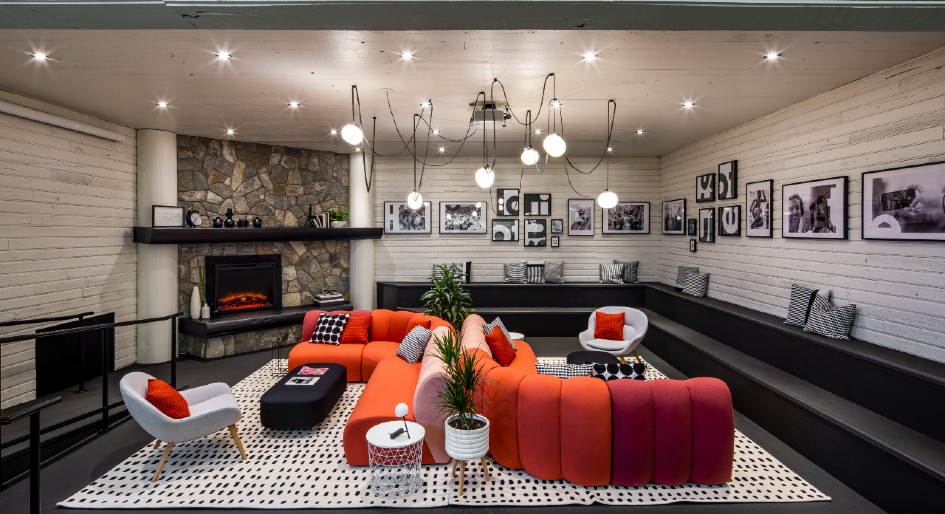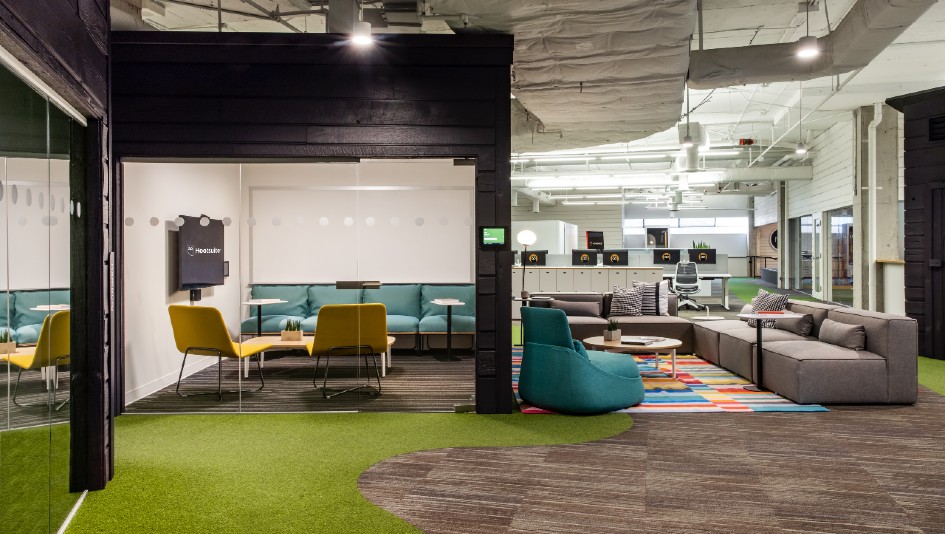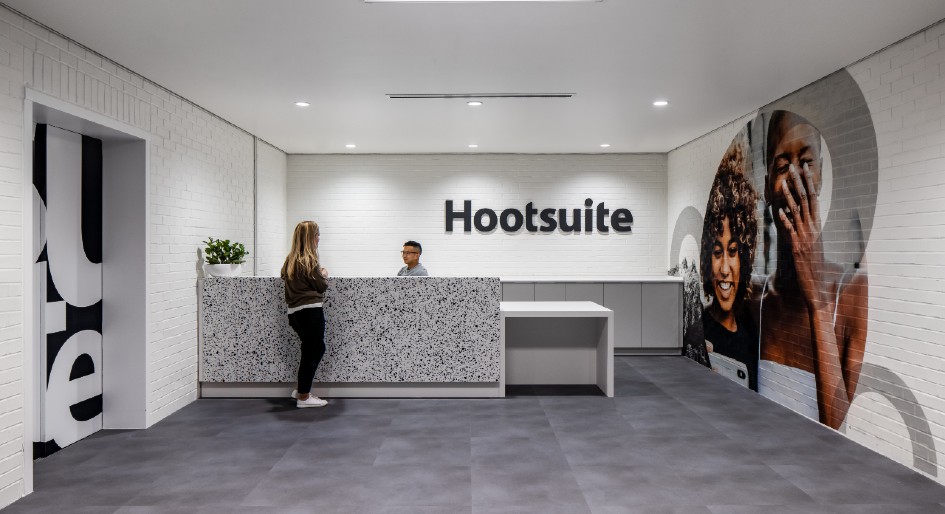Bright-coloured furniture, in a peachy warm palette, curves around a stone fireplace in the lounge of Hootsuite’s newly transformed Vancouver headquarters that was downsized during the pandemic.
The collaborative area reflects the social media management company’s new distributed workforce model, which reimagines global offices over time as inclusive creative hubs. The Vancouver office is piloting this model based on observations directly stemming from workers’ own choices.
Last year, when the pandemic disrupted its office culture, one hinging heavily on in-person connections, the organization surveyed employees to assess the impacts of remote work and to inquire about return-to-work preferences.
With offices in 14 cities across the globe, responses varied depending on the location. Employees missed connecting with colleagues, but treasured the flexibility of working from home, particularly in larger locales like Vancouver, where Hootsuite is headquartered, Toronto, London and Mexico City where workers were commuting up to four hours a day, says Carol Waldmann, director of global facilities and real estate at Hootsuite.
“What we’ve given our workforce now is the control and ability to decide where you work and when you work,” she says.
The impetus to rethink the Vancouver office began pre-pandemic as 50 per cent of assigned desks across two floors were unoccupied on most days due to working remotely. A new design began to materialize after the employee survey revealed eighty-nine per cent of Vancouver-based employees wanted to work in-house a few days each week or month.
From those findings, 150 new work points were created within the 27,000-square-foot space, including personal pods, team pods, and luxurious living areas. Extra lounge furniture and scrum spaces with floor-to-ceiling whiteboards have replaced rows of assigned desks.
“When we reopened the office at a reduced capacity in September, we had some people come in, but it wasn’t that busy,” says Waldmann. “Now, we’re finding the more people come in, the more they are talking to their friends, saying the office is actually really cool; it’s gaining momentum, and so far, it’s been a success.”

Black and white photos of employees grace the walls of the living room. Photo by Upper Left Photography.
Before the redo, the office touted a ski-inspired Canadiana theme, with plaid and natural wood—an aesthetic not every worker could relate to. Few windows contributed to a darker setting and the living room was filled with bean bag chairs. “That’s great when you’re 21, but our workforce is starting to grow up,” says Waldmann. “Many people are saying that their back cannot take working in a bean bag chair for eight hours a day.”
Fresh white walls now brighten the space to reflect as much natural light as possible, with biophilic elements to calm and energize oxygen levels. Sit-stand desks, adjustable monitor arms, and ergonomic chairs add comfort. The meeting rooms, also called cabins, have been painted matte black to reflect the trendy, yet ancient, Japanese technique known as yakisugi, which consists of charring the outer layer of wood to make it more durable.
An inclusive transformation
Various amenities support the mental health of employees—a priority that figures highly into the company’s culture. The space, designed by Mak Interiors and the Hootsuite brand team, harnessed a concept based on inclusion and wellbeing, while working alongside a diversity, equity and inclusion consultant who reviewed the floorplan.
Artwork throughout the space reflects various cultures—of employees throughout the years or branding in general—so people can “see themselves on the walls.”
Braille signage graces the meeting rooms, of which there are a wide variety so people can choose from a number of spots to work throughout the day. Within these spaces, dimmable LEDs accommodate for light sensitivity, while private pods allow for heads-down work and a place for listening to music or meditation apps.
The wellness room is a single-use spot to relax, with a domestic feel of soft blue tones, calming murals and velvet curtains and blankets. There is light therapy for seasonal affective disorder, a green wall and lavender diffuser. The room serves multiple purposes: for nursing mothers with a fridge and sink, a place for prayer and meditation, or an area to retreat for those suffering from migraines.
“If you’re at work and you feel like you need a break, or you have sensory overload, you can go to this room and take a quiet moment,” says Waldmann. “It gives you an oasis of calm.”

Various meeting areas allow workers to choose where they work throughout the day. Photo by Upper Left Photography.
To attract more diverse job candidates, other elements like fully automatic doors and gender-inclusive washrooms are physical representations of the culture Hootsuite is building, which also extends to its benefits that were redesigned this year. These include increasing coverage for mental health to six times the previous amount, fertility treatments, gender affirmation surgeries, culturally appropriate counselling, and global pay equity—achieved across the entire company in 2021.
Hootsuite also shut down its entire operations for its inaugural Wellness Week in July, where employees were given a week off—separate from their vacation allotment. The idea was to help rebuild the mental health of its employees as stress in the workplace is hindering wellbeing at exceptional rates due to the pandemic. They’ve also re-introduced wellness week for 2022.
Greater autonomy of where one works also lends to mental wellbeing. But with embracing a hybrid approach comes the challenge most companies are grappling with—how to foster equity between in-office and work-from-home teams.
At Hootsuite, Waldmann says the issue is front-and-centre. All events are virtual for the foreseeable future, from the company’s recent 13th birthday to town halls and team get-togethers where everyone meets via their laptop with headsets to achieve a similar experience.
“We are constantly thinking of and trying to engage the folks working from home,” she says. “It’s not easy, but it is something that will continue to evolve.”








In case of interest, we just published a video featuring Hootsuite discussing their reimagined workplace strategy!
https://youtu.be/EVgoZFAjuT0